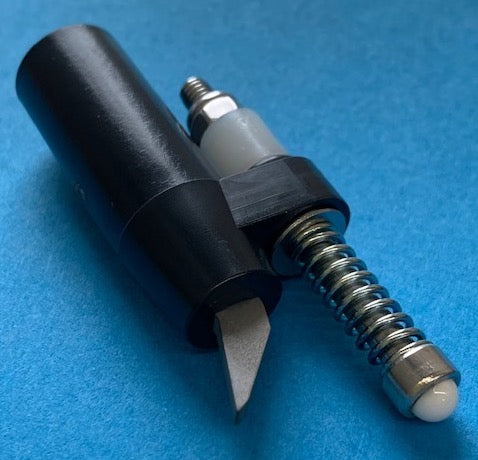A key advantage of the V2 system is that if the spring mechanism should fail, the reliable carbide tip will remain functional.
Assemble using a low melt glue stick. We use a heat gun to melt the stick a bit, then rub the melted glue onto the ski pole and attach the ferrule.
To remove, use a heat gun to loosen the glue, or dip pole/ferrule in a cup of boiling water to loosen the glue.
G5, THE V2 FERRULE THAT REDUCES ELBOW & SHOULDER INJURIES (Patent Pending)
Many skiers have reported injuries, and more frequently aggravation of old injuries, from the shock of the ski pole hitting the pavement. For this reason, some pole companies introduced shock absorbing roller ski ferrules. But skiers told us the carbide tips on the shock absorbing models often broke after a short period of use.
For twenty-five years V2 has had a worldwide reputation for good roller ski ferrules. When they decided to make a shock-absorbing ferrule, they knew from experience that spring loading the carbide tip housing was not the answer. To be durable, the carbide tip must be securely embedded in the plastic housing, and the housing firmly fastened to the ski pole. They decided to use an independent damping system so if it should fail, the carbide tip would still be intact, and the skier would be able to pole home.
Most skiers liked V2's first damping ferrules. The plunger was nylon with a drive screw for the tip. But many skiers reported that more damping would make the ferrule even better. More damping required a metal plunger and a stiffer spring. We chose a grade 12/9 bolt, the hardest 4mm available, but with the increased spring pressure against the pavement, the head of the bolt abraded long before the carbide tip wore down.
Why are paved roads so abrasive? Asphalt is a waterproof bitumen that binds sand and crushed stone. The amount of asphalt in newly paved roads and recreational paths is less than 10%, so over 90% of the road material consists of silica particles in sand and crushed stone that are harder than any metal. The tungsten carbide in V2 ferrules is hard, but only slightly harder than silica. On the Mohs hardness scale, talc is the softest material with a value of 1 and diamond, the hardest of all known materials, a value of 10. The hardest steel on the Mohs scale is 7, while the silica particles are 8 and the tungsten carbide in V2 ferrules 9. Alumina, Al2O3 is 9, the same as tungsten carbide. Old and chip sealed pavement is more abrasive due to less asphalt and more exposed silica.
G5 FERRULE: To be as durable as the carbide tip, the end of the bolt had to be harder than silica. There is no metal hard enough and tungsten carbide bolts are cost prohibitive for this application. The solution was to machine a cavity in the head of a stainless-steel bolt and encapsulate a 5mm alumina ball. Al2O3, is as hard as tungsten carbide and has a very low coefficient of friction. The ball shape also lowers sliding friction reducing the abrasive wear from the silica in the road. Durability data on springs showed that the stiffer, smaller diameter springs might fatigue before the carbide tip wore down. For highly stressed springs fatigue life is hard to predict. Some springs can last a long time while others in the same manufacturing lot have a much shorter life span. Because of this unpredictability every pair of G5 ferrules comes with two extra springs.
Product title
Vendor
$19.99 | $24.99
Product title
Vendor
$19.99 | $24.99
Product title
Vendor
$19.99 | $24.99
Product title
Vendor

